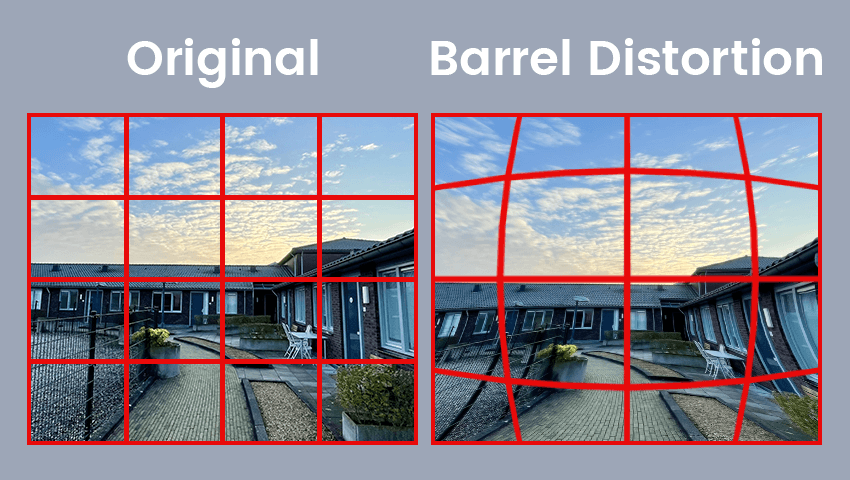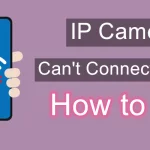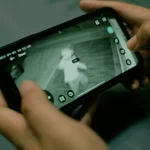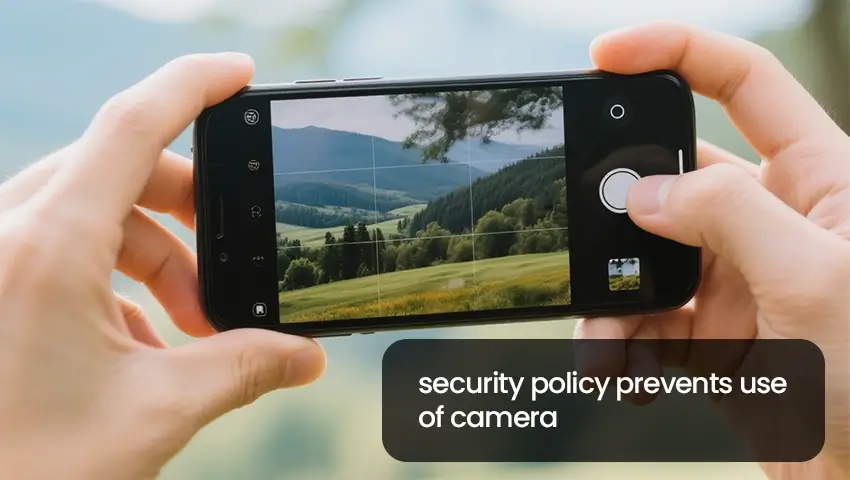If you’ve ever taken a wide-angle photo and noticed straight lines bending outward like a balloon, you’ve encountered barrel distortion. It’s one of the most common lens distortions and can significantly affect image quality—especially in genres where straight lines matter.
This guide explains what barrel distortion is, why it happens, where it’s most noticeable, and how photographers can minimize or correct it without losing image quality.
Contents
What Is Barrel Distortion?
Barrel distortion is an optical phenomenon where straight lines—especially those near the edges of a frame—appear to curve outward from the center, creating a bulging effect that resembles the sides of a barrel.
What It Looks Like
• Imagine photographing a grid of straight lines: instead of remaining straight, lines at the edge of the frame bow outward.
• Common example: shooting a room with a wide-angle lens where door frames or ceiling edges appear curved.
Why It Matters
• In architectural photography, distortion can make buildings look warped.
• In product photography, it misrepresents shape and proportion.
• For casual shots, it might be less noticeable, but in professional work, it can undermine accuracy.
Why Does Barrel Distortion Occur?
Barrel distortion is a result of how lenses project a 3D scene onto a flat 2D sensor. To capture a wide field of view, light rays entering from the edges of the lens bend more than those entering from the center, making the outer parts of the image magnified less than the center.
Key Causes
1. Wide-Angle Lens Design
Lenses with very short focal lengths (14–35mm for full-frame cameras) bend light more aggressively.
2. Field of View
Ultra-wide or fisheye lenses cover up to 180°, requiring optical compromises.
3. Zoom Position
Some zoom lenses show barrel distortion at the wide end and pincushion distortion at the telephoto end.
4. Budget Lens Construction
Lower-cost lenses often use simpler optics, which can exaggerate distortion.
How Does Barrel Distortion Affect Photography?
Barrel distortion has a mixed impact depending on the type of photography:
1. Architectural Photography
Accuracy is crucial. Distortion can make perfectly straight buildings appear curved, creating an unprofessional look.
2. Interior Photography
Real estate images may look unrealistic—rooms appear rounded or inflated, misleading buyers.
3. Product Photography
Distortion alters proportions, which is unacceptable in commercial photography (e.g., an item looking wider than it is).
4. Portrait Photography
At close distances, facial features at the edge may stretch (big noses or distorted cheeks).
5. Creative Photography
Barrel distortion can be used artistically, especially with fisheye lenses for dramatic or fun effects.
Bottom Line:
Barrel distortion can either be a problem (when accuracy matters) or an advantage (when creativity is the goal).
How to Correct Barrel Distortion
1. In-Camera Correction
Many modern cameras, including DSLRs, mirrorless, and even smartphones, have built-in distortion correction features:
• Lens Profiles: Cameras come preloaded with profiles for popular lenses. When enabled, the camera automatically applies digital corrections to JPEG images as you shoot, straightening curved lines.
• ettings to Enable: Look for options named “Lens Correction,” “Distortion Correction,” or “Auto Lens Correction” in your camera’s menu system.
• Limitations: This usually applies only to JPEG files, not RAW images. Some cameras may allow embedded correction metadata for RAW processing later.
2. Post-Processing Correction
The most flexible and precise way to fix barrel distortion is in post-production software:
• Lens Profiles in Software:
Tools like Adobe Lightroom, Photoshop Camera Raw, Capture One, and DxO PhotoLab contain extensive lens profile databases. These profiles are tailored to specific camera and lens combinations and automatically apply distortion corrections, straightening lines while preserving image quality.
• Manual Adjustments:
If your lens isn’t in the database or distortion is unique, you can manually tweak distortion sliders:
• Distortion slider: Adjusts the strength of barrel or pincushion correction.
• Transform tools: Some programs allow you to warp or straighten specific areas manually.
• Shooting in RAW:
RAW files retain the maximum image data, allowing you to apply distortion correction non-destructively with minimal quality loss.
• Batch Processing:
Many software solutions enable applying distortion correction across multiple images simultaneously, ideal for large shoots.
3. Lens Choice and Shooting Techniques
Reducing distortion begins with your equipment and shooting approach:
• Use High-Quality, Low-Distortion Lenses:
Premium lenses, especially those designed for architectural or product photography, are optically engineered to minimize distortion. Tilt-shift lenses, for example, offer near-zero distortion but come at a higher cost.
• Avoid Ultra-Wide Angles When Possible:
The wider the lens, the more prone it is to barrel distortion. Using moderate wide-angle lenses (e.g., 24-35mm) instead of ultra-wide (14-20mm) can reduce distortion.
• Increase Distance from Subject:
Shooting further back and cropping later can reduce the effect of distortion compared to close-up wide-angle shots.
• Compose Carefully:
Keep important straight lines near the center of the frame where distortion is minimal.
4. Use Dedicated Software Plugins
For advanced users, some third-party plugins offer enhanced distortion correction:
• PTLens: Widely used for precise correction of complex lens distortions.
• DxO ViewPoint: Specialized for geometry correction including perspective and distortion fixes.
• Hugin: Open-source panorama software with lens correction tools.
5. Consider Creative Use Instead of Correction
In some cases, embracing barrel distortion for its artistic value can be better than correcting it—especially for:
• Fisheye photography
• Creative portraits
• Skateboarding or action shots with dynamic perspectives
Knowing when to correct vs. when to keep distortion is part of mastering your photography style.
Is Barrel Distortion Always Bad?
Not always. While distortion is undesirable in technical genres like architecture or real estate, some photographers use it creatively:
Fisheye lenses intentionally exaggerate barrel distortion for a dramatic, artistic look.
In sports or action photography, slight distortion might be invisible or even add energy.
Bottom line:
Distortion isn’t a flaw—it’s a trade-off between wide coverage and geometry accuracy. The key is knowing when and how to manage it.
FAQs
1. Does barrel distortion affect image quality?
Barrel distortion mainly impacts geometry, not resolution. It makes straight lines appear curved but doesn’t reduce sharpness or color quality. For genres like architecture and product photography, this distortion can be problematic.
2. Which lenses are most prone to barrel distortion?
Wide-angle and ultra-wide lenses are most susceptible. Zoom lenses often show barrel distortion at their widest focal lengths, while budget lenses tend to have stronger distortion due to simpler optics.
3. How can I fix barrel distortion in photos?
Use software correction:
In-camera correction: Enable lens profile corrections.
Post-processing: Use tools like Adobe Lightroom or Photoshop with lens profiles.
Plugins: Advanced tools such as DxO ViewPoint or PTLens offer precise control.
Conclusion
Barrel distortion is a natural trade-off when using wide-angle lenses. With today’s advanced optics and editing tools, fixing it is easy, so you can enjoy wide-angle creativity without sacrificing quality.
Understanding distortion—and how to manage it—gives you more control, whether you’re shooting buildings, portraits, or landscapes.





